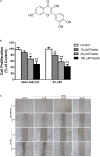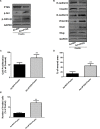Fisetin Inhibited Growth and Metastasis of Triple-Negative Breast Cancer by Reversing Epithelial-to-Mesenchymal Transition via PTEN/Akt/GSK3β Signal Pathway
- PMID: 30108501
- PMCID: PMC6080104
- DOI: 10.3389/fphar.2018.00772
Fisetin Inhibited Growth and Metastasis of Triple-Negative Breast Cancer by Reversing Epithelial-to-Mesenchymal Transition via PTEN/Akt/GSK3β Signal Pathway
Abstract
Triple negative breast cancer (TNBC), characterized by its highly aggressive and metastatic features, is associated with poor prognosis and high mortality partly due to lack of effective treatment. Fisetin, a natural flavonoid compound, has been demonstrated to possess anti-cancer effects in various cancers. However, the effects and mechanisms of fisetin on metastasis of TNBC remain uncovered. In this study, we found that fisetin dose-dependently inhibited cell proliferation, migration and invasion in TNBC cell lines MDA-MB-231 and BT549 cells. In addition, fisetin reversed epithelial to mesenchymal transition (EMT) as evaluated by cell morphology and EMT markers in MDA-MB-231 and BT549 cells. Furthermore, fisetin suppressed phosphoinositol 3-kinase (PI3K)-Akt-GSK-3β signaling pathway but upregulated the expression of PTEN mRNA and protein in a concentration-dependent manner. Further, silence of PTEN by siRNA abolished these benefits of fisetin on proliferation and metastasis of TNBCs. In vivo, using the metastatic breast cancer xenograft model bearing MDA-MB-231 cells, we found that fisetin dramatically inhibited growth of primary breast tumor and reduced lung metastasis, meanwhile, the expression of EMT molecules and PTEN/Akt/GSK-3β in primary and metastatic tissues changed in the same way as those in vitro experiments. In conclusion, all these results indicated that fisetin could effectively suppress proliferation and metastasis of TNBC and reverse EMT process, which might be mediated by PTEN/Akt/GSK-3β signaling pathway.
Keywords: AKT; EMT; PTEN; fisetin; triple negative breast cancer.
Figures






Similar articles
-
Shikonin inhibits migration and invasion of triple-negative breast cancer cells by suppressing epithelial-mesenchymal transition via miR-17-5p/PTEN/Akt pathway.J Cancer. 2021 Jan 1;12(1):76-88. doi: 10.7150/jca.47553. eCollection 2021. J Cancer. 2021. PMID: 33391404 Free PMC article.
-
Propolin G-Suppressed Epithelial-to-Mesenchymal Transition in Triple-Negative Breast Cancer Cells via Glycogen Synthase Kinase 3β-Mediated Snail and HDAC6-Regulated Vimentin Degradation.Int J Mol Sci. 2022 Jan 31;23(3):1672. doi: 10.3390/ijms23031672. Int J Mol Sci. 2022. PMID: 35163593 Free PMC article.
-
Shikonin inhibits triple-negative breast cancer-cell metastasis by reversing the epithelial-to-mesenchymal transition via glycogen synthase kinase 3β-regulated suppression of β-catenin signaling.Biochem Pharmacol. 2019 Aug;166:33-45. doi: 10.1016/j.bcp.2019.05.001. Epub 2019 May 6. Biochem Pharmacol. 2019. PMID: 31071331
-
The "Yin and Yang" of Natural Compounds in Anticancer Therapy of Triple-Negative Breast Cancers.Cancers (Basel). 2018 Sep 21;10(10):346. doi: 10.3390/cancers10100346. Cancers (Basel). 2018. PMID: 30248941 Free PMC article. Review.
-
The Role of PTEN in Epithelial-Mesenchymal Transition.Cancers (Basel). 2022 Aug 3;14(15):3786. doi: 10.3390/cancers14153786. Cancers (Basel). 2022. PMID: 35954450 Free PMC article. Review.
Cited by
-
Targeting the key players of phenotypic plasticity in cancer cells by phytochemicals.Cancer Metastasis Rev. 2024 Mar;43(1):261-292. doi: 10.1007/s10555-023-10161-8. Epub 2024 Jan 3. Cancer Metastasis Rev. 2024. PMID: 38169011 Review.
-
Fisetin, a Potent Anticancer Flavonol Exhibiting Cytotoxic Activity against Neoplastic Malignant Cells and Cancerous Conditions: A Scoping, Comprehensive Review.Nutrients. 2022 Jun 23;14(13):2604. doi: 10.3390/nu14132604. Nutrients. 2022. PMID: 35807785 Free PMC article.
-
Fisetin: An anticancer perspective.Food Sci Nutr. 2020 Nov 25;9(1):3-16. doi: 10.1002/fsn3.1872. eCollection 2021 Jan. Food Sci Nutr. 2020. PMID: 33473265 Free PMC article. Review.
-
Management of triple-negative breast cancer by natural compounds through different mechanistic pathways.Front Genet. 2024 Jul 26;15:1440430. doi: 10.3389/fgene.2024.1440430. eCollection 2024. Front Genet. 2024. PMID: 39130753 Free PMC article. Review.
-
Anticancer Activities of Thymus vulgaris L. in Experimental Breast Carcinoma in Vivo and in Vitro.Int J Mol Sci. 2019 Apr 9;20(7):1749. doi: 10.3390/ijms20071749. Int J Mol Sci. 2019. PMID: 30970626 Free PMC article.
References
LinkOut - more resources
Full Text Sources
Other Literature Sources
Research Materials
Miscellaneous

